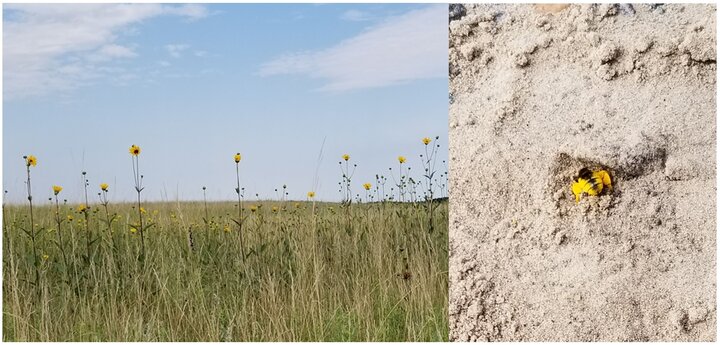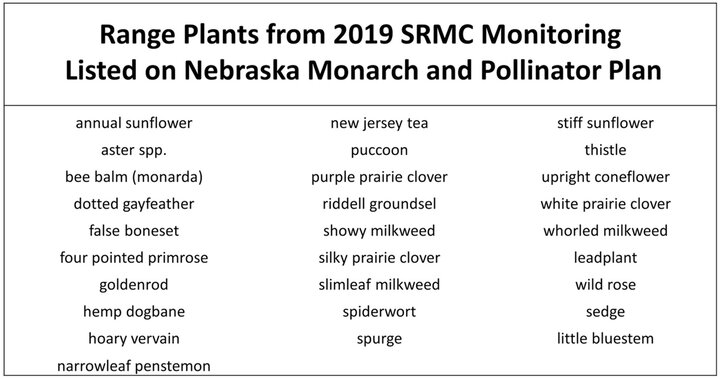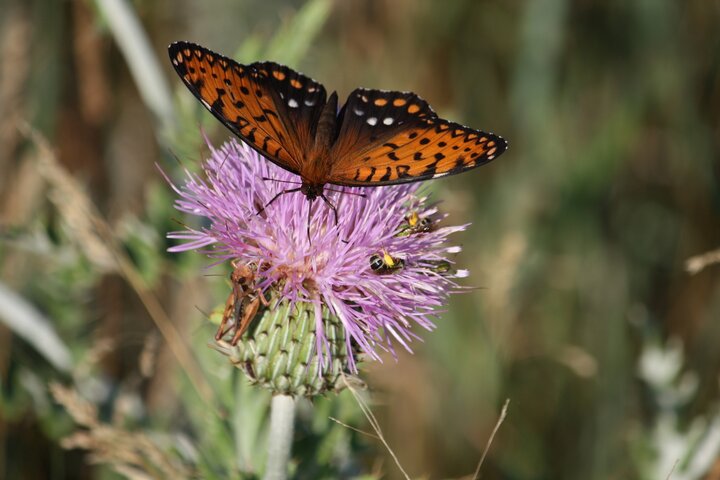Native rangelands are well known for their importance as a forage resource to beef cattle and other livestock. These same rangelands are also an essential resource for smaller six-legged foragers: insect pollinators. Insect pollinators include a diverse number of species of beetles, flies, wasps, butterflies, moths, and bees, many of which are found on rangelands in Nebraska. Pollinators are integral in maintaining healthy ecosystems and food security for humans.
Habitat loss, pesticide exposure, disease, and climate change are putting pollinators at risk worldwide and many have been reported to have declined over the past several decades. In order to understand how rangelands can benefit pollinating insects, we must consider pollinator habitat requirements. Because pollinating insects come in many shapes and sizes, each species’ specific habitat needs differ. General pollinator habitat requirements include season-long quality floral resources (nectar, pollen, flower leaves, and petals), access to water, nest sites (stems, cavities, and bare ground), host plants (e.g., many butterflies and moths lay their eggs on specific plants, known as host plants), and overwintering sites (soil, litter, and vegetation). Native rangelands are an important stronghold of natural habitat for pollinator insects.
Why are rangelands important to pollinators?
Rangelands offer large swaths of natural vegetation that can provide a continuity of habitat in increasingly fragmented landscapes. Native plant communities found within these areas provide shelter, food, and refuge for a wide variety of beneficial insects including pollinators. Promoting, maintaining, and enhancing pollinator habitat can even be incorporated into effective livestock grazing management goals. For example, rotating pastures to allow certain plants opportunities to flower before grazing.
Why are pollinators important to rangelands?
Pollinators directly benefit rangeland plant communities by pollinating native flowering plants which help stabilize the soil and shape a healthy and resilient ecosystem. Pollinators are an integral part of the food chain, as many game bird species rely on their immature grubs for nutrition. Pollinators are also needed for the reproduction of many rare or endangered range plants. For example, the western prairie fringed orchid requires select species of hawkmoth which visits these flowers at night to drink nectar. Pollen attaches to the face of the moth and gets carried from one flower to the next.
Nebraska Sandhills habitat
Nebraska is home to 22 million acres of rangeland and pastureland, half of which are in the Sandhills. Beef production focuses on enhancing the productivity of nutrient-rich grasses that dominate our Nebraska rangelands. However, healthy grasslands also contain a diversity of forbs and shrubs which offer food and resources to a wide variety of pollinating insects.
The Nebraska Sandhills contains a unique set of associated plants, with approximately 720 different plant species (90% identified as native species). This large unbroken expanse of native rangeland with its diversity of nutrient-rich forage makes is ideal for cattle grazing while providing habitat resources for pollinators. Warm and cool-season grasses typically dominate the production of vegetation on Sandhills uplands (approximately 70 to 80% of the total plant production), but forbs and shrubs are an important component of the plant community (approximately 15 to 25% of total plant production).

Forbs and shrubs make up the majority of pollinator plant lists due to nectar and pollen rewards they offer to insects in exchange for pollination. In 2017, the Nebraska Game and Parks Commission published the Nebraska Monarch and Pollinator Conservation Plan complete with a list of native Nebraska plants for pollinators, including many plants found in the Nebraska Sandhills. During the summer of 2019, the Sandhills Rangeland Monitoring Cooperative (SRMC) conducted vegetation monitoring on 70 upland “Sands” ecological sites on pastures across seven cooperating ranches in the western and central Sandhills. Forbs and shrubs made up 72% of the 94 total plant species found on the upland pastures monitored in 2019. Of the forbs and shrubs found monitoring in 2019, 28 are listed as pollinator plants for the Nebraska Monarch and Pollinator Conservation Plan (Figure 2). Although the SRMC project is not directly monitoring for pollinator habitat, it is important to acknowledge the role that healthy rangelands have in promoting important insect pollinators. Next time you find yourself admiring the beauty of the Sandhills, take a moment to notice what flowering plants are around and you may even happen upon one of our rangeland pollinators at work.

To learn more about the SRMC project, read the UNL BeefWatch article titled: What Should my Pastures Look Like?
To read more about pollinator habitat and rangelands, check out these links:
Rangeland Management and Pollinators: A Guide for Producers in the Great Plains
Natural Areas and Rangelands: Pollinator Habitat Assessment Guide
Conservation Strategy for Monarchs (Danaus plexippus) and At-Risk Pollinators in Nebraska
Rangelands: Society of Range Management Special Issue on Pollinators
Grazing Management with Variable Plant Production in the Nebraska Sandhills
Interviews with the authors of BeefWatch newsletter articles become available throughout the month of publication and are accessible at https://go.unl.edu/podcast.

